Hawaiian monk seal
| Hawaiian monk seal | |
|---|---|
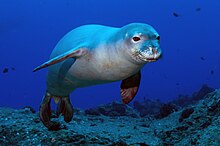
| |
| Hawaiian monk seal at Kaʻula | |
| Scientific classification | |
| Domain: | Eukaryota |
| Kingdom: | Animalia |
| Phylum: | Chordata |
| Class: | Mammalia |
| Order: | Carnivora |
| Clade: | Pinnipedia |
| Family: | Phocidae |
| Genus: | Neomonachus |
| Species: | N. schauinslandi
|
| Binomial name | |
| Neomonachus schauinslandi (Matschie, 1905)
| |

| |
| Hawaiian monk seal range | |
| Synonyms | |
|
Monachus schauinslandi | |
The Hawaiian monk seal (Neomonachus schauinslandi) is an
The Hawaiian monk seal is one of two extant monk seal species; the other is the Mediterranean monk seal. A third species, the Caribbean monk seal, is extinct.[3]
The Hawaiian monk seal is the only seal native to Hawaii, and, along with the Hawaiian hoary bat, is one of only two mammals endemic to the islands.[4]
N. schauinslandi is a
Etymology
Known to native Hawaiians as ʻIlio-holo-i-ka-uaua, or "dog that runs in rough water", its
Description
Its grey coat, white belly, and slender physique distinguish them from their cousin, the
The Hawaiian monk seal is part of the family
Adult males are 140 to 180 kilograms (300 to 400 pounds) in weight and 2.1 metres (7 feet) in length while adult females tend to be, on average, slightly larger, at 180 to 270 kg (400 to 600 lb) and 2.4 m (8 ft) in length. When monk seal pups are born, they average 14 to 18 kg (30 to 40 lb) and 1 m (40 in) in length. As they nurse for approximately six weeks, they grow considerably, eventually weighing between 70 and 90 kg (150 and 200 lb) by the time they are weaned, while the mother loses up to 140 kg (300 lb).
Monk seals, like
Evolution and migration
The monk seals are members of the Phocidae. In an influential 1977 paper, Repenning and Ray proposed, based on certain unspecialized features, that they were the most primitive living seals.[17] However, this idea has since been entirely superseded.
In an effort to inform the public and conserve the seals, the
Berta and Sumich ask how this species came to the Hawaiian Islands when its closest relatives are on the other side of the world in the
Ecology
Habitat
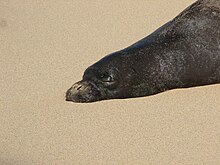
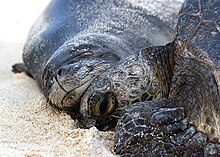
The majority of the Hawaiian monk seal population can be found around the
Feeding
Hawaiian monk seals mainly prey on reef dwelling
Hawaiian monk seals can hold their breath for up to 20 minutes and dive more than 550 m (1,800 ft); however, they usually dive an average of 6 minutes to depths of less than 60 m (200 ft) to forage at the seafloor.[22]
Predators
Behavior
Reproduction
Hawaiian monk seals mate in the water during their breeding season, which occurs between June and August.[3] Females reach maturity at age four and give birth to one pup a year. The fetus takes nine months to develop, with birth occurring between March and June. Pups start around 16 kg (35 lb) and are about 1 m (3 ft 3 in) long.[24]
Nursing
The pups are born on beaches and nursed for about six weeks. The mother does not eat or leave the pup while nursing. After that time, the mother deserts the pup, leaving it on its own, and returns to the sea to forage for the first time since the pup's arrival.[15]
Status
Most seals are found on the Northwestern Hawaiian Islands.[25]
The Hawaiian monk seal is endangered,[26] although its cousin species, the Mediterranean monk seal (M. monachus), is even rarer, and the even more closely related Caribbean monk seal (N. tropicalis), last sighted in the 1950s, was officially declared extinct in June 2008.[27] In 2010, it was estimated that only 1100 individuals remained. A later estimate in 2016, which included a more complete survey of small populations, was approximately 1400 individuals.[5]
Seals nearly disappeared from the main islands, but the population has begun to recover. The growing population there was approximately 150 as of 2004

The Hawaiian monk seal was officially designated as an
Threats
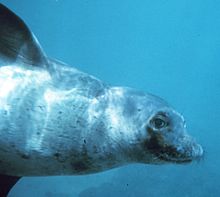
Natural factors threatening the Hawaiian monk seal include low juvenile survival rates, reduction of habitat/prey associated with environmental changes, increased male aggression, and subsequent skewed gender ratios.[32] Anthropogenic or human impacts include hunting (during the 1800s and 1900s) and the resulting small gene pool, continuing human disturbance, entanglement in marine debris, and fishery interactions.[32]
Natural threats
Low juvenile survival rates continue to threaten the species. High juvenile mortality is due to starvation and marine debris entanglement.[8] Another contributor to the low juvenile survival rates is predation from sharks, including tiger sharks. Most mature monk seals bear scars from shark encounters, and many such attacks have been observed.[32]
Reduced prey abundance can lead to starvation, with one cause being reduction in habitat associated with environmental change.[32] Habitat is shrinking due to erosion in the Northwest Hawaiian Islands, reducing the size of islands/beaches.[32] Lobsters, the seals' preferred food other than fish, have been overfished. Competition from other predators such as sharks, jacks, and barracudas leaves little for developing pups. The creation of Papahānaumokuākea Marine National Monument which encloses these islands may expand food supplies.
Mobbing is a practice among the seals that involves multiple males attacking one female in mating attempts. Mobbing is responsible for many deaths, especially to females.[33]
Mobbing leaves the targeted individual with wounds that increase vulnerability to sepsis, killing the victim via infection.[33] Smaller populations were more likely to experience mobbing as a result of the higher male/female ratio and male aggression. Unbalanced sex-ratios were more likely to occur in slow-growing populations.[34][35]
Anthropogenic impacts
In the nineteenth century, large numbers of seals were killed by
The Hawaiian monk seal has the lowest level of genetic variability among the 18 phocid species.[8] This low genetic variability was allegedly due to a population bottleneck caused by intense hunting in the 19th century.[8] This limited genetic variability reduces the species ability to adapt to environmental pressures and limits natural selection, thus increasing their risk of extinction.[8] Given the monk seal's small population, the effects of disease could be disastrous.
Monk seals can be affected by the toxoplasmosis pathogen in cat feces that enters the ocean in polluted runoff and wastewater, a new phenomenon.[40] Since 2001, toxoplasmosis has killed at least eleven seals.[41] Other human-introduced pathogens, including leptospirosis, have infected monk seals.[40]
Human disturbances have had immense effects on the populations of the Hawaiian monk seal. Monk seals tend to avoid beaches where they are disturbed; after continual disturbance the seal may completely abandon the beach, thus reducing its habitat size, subsequently limiting population growth. For instance, large beach crowds and beach structures limit the seal's habitat.[7][32][40] Although the WWII military bases in the northwestern islands were closed, minimal human activities can be enough to disturb the species.[32]
Marine fisheries can potentially interact with monk seals via direct and indirect relationships. Directly the seal can become snared by fishing equipment, entangled in discarded debris, and even feed on fish refuse.[32] Although international law prohibits the intentional discarding of debris from ships at sea, entanglement still results in mortality because the seals get trapped in unintentional marine debris such as fishing nets and cannot maneuver or even reach the surface to breathe.[8] Monk seals have one of the highest documented rates of entanglement of any pinniped species.[32]
Conservation
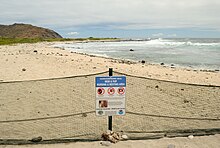

In 1909, President
From NOAA, several programs and networks were formed to help the Hawaiian monk seal. Community programs such as PIRO have helped to improve community standards for the Hawaiian monk seal. The program also creates networks with the Native Hawaiians on the island to network more people in the fight for conservation of the seals. The Marine Mammal Response Network (MMRN) is partnered with NOAA and several other government agencies that deal with land and marine wildlife.[43]
The Recovery Plan for the Hawaiian Monk Seal identifies public outreach and education as a key action for promoting the conservation of the Hawaiian monk seal and its habitat.[42]
To raise awareness of the species' plight, on June 11, 2008, a state law designated the Hawaiian monk seal as Hawaii's official State Mammal .[44]
The task is to identify a manner of alleviation that is possible, cost-effective, and likely to maximize the organic return (in terms of growth potential) until much time has passed and natural conditions allow scientists to observe the effects.[32]
Protecting female pups
One key natural factor affecting the seal populations is the male-biased sex-ratio, which results in increased aggressive behaviors such as mobbing.[34] These aggressive behaviors decrease the number of females in the population. Two programs effectively aid female survival rates.
A headstarting project began in 1981, collecting and tagging female pups after weaning and placing them in a large, enclosed water and beach area with food and lacking disturbances.[45] The female pups remain during the summer months, leaving at roughly age three to seven months.
Another project began in 1984 at French Frigate Shoals. It collected severely underweight female pups, placed them in protective care, and fed them. The pups were relocated to Kure Atoll and released as yearlings.[45]
Some habitats are better suited to increase survival probability, making relocation a popular and promising method.[9] Although no direct links between infectious diseases and seal mortality rates have been found, unidentified infectious diseases could prove detrimental to relocation strategies.[46] Identification and mitigation of these and other possible factors limiting population growth represent ongoing challenges and are the primary objectives of the Hawaiian monk seal conservation and recovery effort.[36]
It is also important to consider the mothers who nurse their pups. Seal milk is very rich in nutrients, allowing pups to gain weight rapidly. With the rich milk from the mother, the pup is more likely to quadruple its initial weight before weaning. The mother seal also loses a tremendous amount of weight while nursing.[47]
Draft environment impact statement
In 2011, the National Marine Fisheries Service issued a controversial draft programmatic environmental impact statement intended to improve protections for the monk seal.[48] The plan includes:
- Expanded surveys using technology such as remote cameras and unmanned, remotely operated aircraft.
- Vaccination studies and vaccination programs.
- De-worming program to improve juvenile survival.
- Relocation to the Northwestern Hawaiian Islands.
- Diet supplements at feeding stations in the Northwestern Hawaiian Islands.
- Tools to modify undesirable contact with people and fishing gear in the main islands.
- Chemical alteration of aggressive monk seal behavior.
See also
References
- ^ .
- ^ "Hawaiian Monk Seal, Monachus schauinslandi ". monachus-guardian.org. 2006. Retrieved May 23, 2011.
- ^ a b c d e "Hawaiian Monk Seal (Monachus schauinslandi)". NOAA Fisheries Office of Protected Resources. Retrieved March 11, 2011.
- ^ Nitta, Eugene; Henderson JR (1993). "A review of interactions between Hawaii's fisheries and protected species" (PDF). Marine Fisheries Review. 83. 55 (2). Retrieved May 23, 2011.
- ^ a b c "Monk Seal: Population Size and Threats". Pacific Islands Regional Office, NOAA Fisheries, Dept. of Commerce. Retrieved February 17, 2017.
- ^ Solomon, Molly (January 25, 2017). "Hawaiian Monk Seal Population On The Rise". hpr2.org. Honolulu, HI: Hawaii Public Radio. Retrieved June 11, 2018.
- ^ PMID 14607537.
- ^ PMID 18815116.
- ^ S2CID 25475001.
- ISBN 978-0-375-41141-0.
- ^ Hawaii State Legislature. "Haw. Rev. Stat. § 5-12.5 (State mammal)". Retrieved November 7, 2014.
- ^ S2CID 84310964. Retrieved May 23, 2011.
- ^ .
- ^ Gilmartin, William; Forcada, J. (2002). Encyclopedia of Marine Mammals (ed.). Monk Seals. pp. 756–759.
- ^ hdl:10125/7958. Retrieved May 23, 2011.
- ISBN 978-0-12-373553-9.
- ^ Repenning, CA; Ray, CE (1977). "The origin of the Hawaiian monk seal". Proc. Biol. Soc. Wash. 89: 667–688.
- ^ "Historical Timeline of the Hawaiian Monk Seal" (PDF). National Marine Fisheries Service, Pacific Islands Regional Office. Honolulu, HI, USA. June 29, 2011. Retrieved November 19, 2012.
- )
- . Retrieved May 23, 2011.
- ^ Parrish, Frank A (1999). In: Hamilton RW, Pence DF; Kesling DE Assessment; Feasibility of Technical Diving Operations for Scientific Exploration (eds.). Use of Technical Diving to Survey Forage Habitat of the Endangered Hawaiian Monk Seal. American Academy of Underwater Sciences. Archived from the original on January 13, 2013. Retrieved May 23, 2011.
{{cite book}}: CS1 maint: unfit URL (link) - ^ "Hawaiian Monk Seal". NOAA Fisheries. Retrieved November 26, 2018.
- .
- ^ "Hawaiian Monk Seal". National Wildlife Federation. Retrieved July 7, 2015.
- ^ ISBN 978-0-06-055804-8.
- ^ "The Captive Care and Release Research Project Seeks to Aid Recovery of the Endangered Hawaiian Monk Seal". NOAA. Retrieved May 23, 2011.
- ^ "Feds: Caribbean Monk Seal Officially Extinct". Fox News. Associated Press. June 9, 2008. Retrieved May 23, 2011.
- ^ "Turtle Bay". MonkSealMania.blogspot.com. 2012. Retrieved November 19, 2012.
- ^ Davis, Chelsea (June 29, 2017). "In a rare sight, Hawaiian monk seal and her pup make Waikiki beach home". HawaiiNewsNow. Retrieved June 29, 2017.
- ^ Wianecki, Shannon. "Rough Water Pups". Maui Magazine. Archived from the original on July 23, 2011. Retrieved May 23, 2011.
- ^ Weber, Gretchen. "A struggle to survive: Environmental threats endanger monk seals". PBS. Retrieved May 23, 2011.
- ^ a b c d e f g h i j k Antonelis, GA; et al. (2006). "Hawaiian monk seal (Monachus schauinslandi): status and conservation issues". Atoll Res Bull. 543: 75–101 (88–89).
- ^ S2CID 27886224.
- ^ JSTOR 2386398.
- ^ "Hawaiian Monk Seals". earthtrust.org. Archived from the original on May 15, 2011. Retrieved May 23, 2011.
- ^ .
- S2CID 13562317.
- S2CID 24981002.
- ^ a b
ISBN 978-0-06-055804-8.
- ^ a b c Dawson, Teresa (December 7, 2010). "A New Threat to Hawaiian Monk Seals: Cat Parasite Carried by Runoff, Sewage — Environmental Health News". Environmental Health News: Front Page. Archived from the original on January 21, 2015. Retrieved March 16, 2011.
- Salon. August 8, 2019 – via ProMED-mail.
- ^ a b "Second Revision of Recovery Plan for the Hawaiian Monk Seal (Monachus schauinslandi)" (PDF). Pacific Islands Fisheries Science Center of the National Marine Fisheries Service, part of the National Oceanic and Atmospheric Administration. Honolulu, HI, USA. January 28, 2010 [2007]. Archived from the original (PDF) on October 6, 2006. Retrieved November 24, 2012.
- ^ "Hawaiian Monk Seal Recovery Program". NOAA Fisheries Service Protected Resources Division. Retrieved November 24, 2012.
- ^ Gladden, Tracy (June 12, 2008). "Hawaiian monk seal is the new state mammal". KHNL NBC 8 Honolulu Hawaii. Archived from the original on August 11, 2011. Retrieved May 23, 2011.
- ^ JSTOR 2385936.
- PMID 17495307.
- ^ Hawaiian Monk Seal. U.S. Fish and Wildlife Service.
- ^ "Fisheries Service to hold hearings on monk seals". The Maui News. September 6, 2011.
External links
- "Aloha Kanaloa Coalition". Retrieved November 24, 2012. (public service video)
- Bernard, Hannah (July 8, 2009). "Watching Out for Makana – Maui Magazine – Summer 2004 – Maui, Hawaii". Archived from the original on October 5, 2012. Retrieved November 24, 2012.
- Harker, George R. (November 27, 2010). "Some Observations on a Monk Seal Mother and Pup: Field Notes of Observations of Hawaiian Monk Seal (Monachus schauinslandi)" (PDF). Guide to Nude Beaches & Recreation – Dr. Leisure. Retrieved November 24, 2012.
- "Hawaii's 'Forbidden Island': Weekend Window to Niihau – ABC News". ABC News. October 11, 2010. Retrieved November 24, 2012.
- "Kaua'i Monk Seal Watch Program". Retrieved November 24, 2012.
- "Monk Seal Foundation". Archived from the original on April 15, 2013. Retrieved November 24, 2012.
- "Na Mea Hulu | Protecting the Hawaiian Monk Seals". Retrieved November 24, 2012.
- "NOAA PIFSC 2006–2007 Captive Care and Release Project Seeks to Aid Recovery of the Endangered Hawaiian Monk Seal". Retrieved November 24, 2012.
- "NOAA PIFSC Hawaiian Monk Seal Research". Retrieved November 24, 2012.
- "Oʻahu Supporters BLOG".
- "Scuba diving with Monk Seals in Hawaii – Oahu Diving in Honolulu". Retrieved November 24, 2012.
- "Seal Conservation Society – Hawaiian Monk Seal".

